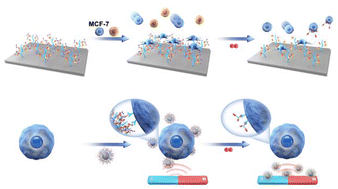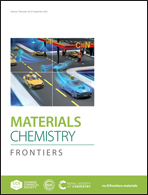Dynamic display of cell targeting motifs via natural glycopeptide recognition for cancer cell isolation†
Abstract
Reversible binding of cell targeting motifs on biomaterial surfaces can be used to mimic the dynamic bioactivities of the extracellular matrix (ECM), thus showing potential to modulate cell behaviours in physiopathologic processes. As the markers of tumour metastasis, circulating tumour cells (CTCs) are especially essential for the diagnosis of cancer. Dynamic display of cancer targeting motifs on biometric interfaces thus enables specific isolation of rare cancer cells and delivery of critical information for cancer therapy. In this work, we report a dynamic biointerface for the reversible binding of cancer-targeting motifs on quartz through molecular recognition between the natural glycopeptide vancomycin (Van) and the D-alanine-D-alanine (AA) dipeptide. This active surface could not only realize specific cancer cell adhesion but also induce nondestructive cell detachment by the competitive addition of the free AA dipeptide. The cell isolation efficiency in the medium could reach 70% within 120 min, showing high specificity and separation efficiency. Furthermore, the dynamic display of cancer-targeting motifs on magnetic beads enabled magnetic cancer cell capture and AA dipeptide-triggered cell release. Therefore, the natural dynamic strategy using noninvasive glycopeptide recognition holds promise for rare cell detection, isolation and cell-based disease diagnosis.

- This article is part of the themed collection: Materials Chemistry Frontiers Emerging Investigator Series 2022–2023


 Please wait while we load your content...
Please wait while we load your content...